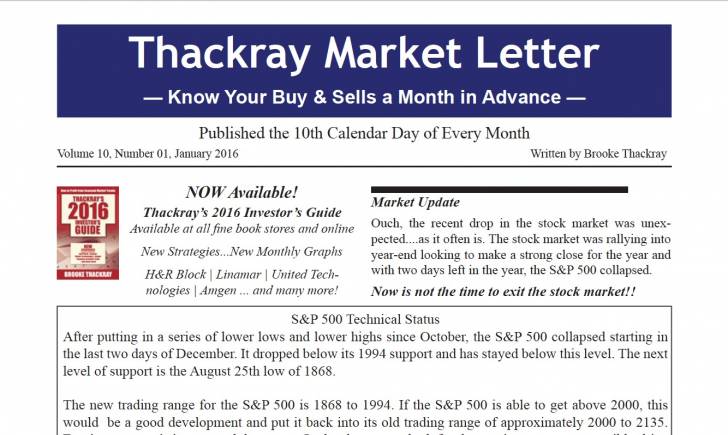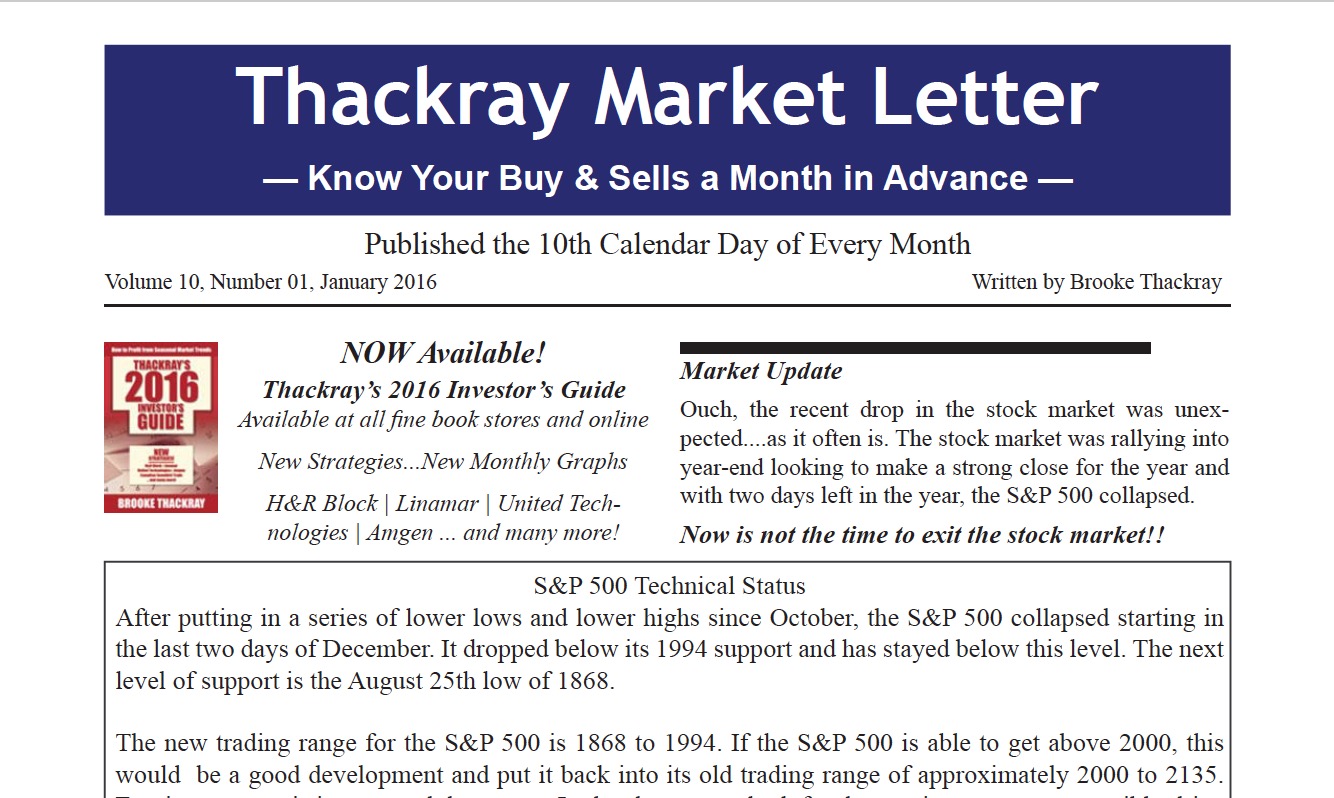
Brooke Thackray – Market Update January 2016
by Brooke Thackray, Alphamountain Investments
Ouch, the recent drop in the stock market was unexpected.... as it often is. The stock market was rallying into year-end looking to make a strong close for the year and with two days left in the year, the S&P 500 collapsed.
Now is not the time to exit the stock market!!
First, a lot of the damage has already been done. It is true that the stock market can fall further, but from the peak of the S&P 500® in May 2015, to the August 1868 low, we are more than halfway down. Exiting the market at this time exposes investors to the risk that the market could have a snap back rally on positive earnings or positive economic news. Although this is true at any time, it is more likely after a major correction.
Second, we are still currently in the favorable six month period for the stock market (October 28th to May 5th), where stocks tend to perform well and the seasonal risk reward profile makes sense for investors to stay in the stock market. Aside from the stronger average performance of stocks during this period, historically there have been more large gains and fewer big losses compared to the unfavorable six month period of the year for stocks (May 6th to October 27th).
In the favorable six month time period for stocks, from 1950 to 2015, the S&P 500® has produced gains greater than 10%, twenty-six times and losses greater than 10% two times. In comparison, in the unfavorable six month period for stocks, the S&P 500® has produced gains and losses greater than 10%, eight times in both cases.
In other words, the period that we are in right now, the favorable six month period for stocks, tends to have more large gains and fewer large losses compared to the unfavorable period for stocks. Yes, a large loss can occur at this time, but based upon seasonal trends, it is less likely to occur during the favorable period for stocks.
The bear market of 2008/2009 was a trying time for investors. The S&P 500® corrected sharply in the favourable six month period for stocks. If an investor had exited in the early part of 2009 it would have been very difficult for them to get back into the market. Ironically, the S&P 500 was positive in the favourable period for stocks in 2008/2009, despite the large drop in the stock market.
To be clear, from a seasonal perspective it is best not to exit the stock market in an attempt to avoid downdrafts during the favourable six month period for stocks. On the other hand, such a strategy can be prudent in the unfavourable six month period for stocks. The rationale for this is that the stock market is more likely to decline in its unfavorable six month period.
China Syndrome….In Reverse
Once again it has been China’s economy and its volatile stock market that has been roiling the world wide stock markets. In the end, the Dow Jones and S&P 500 both had their worst first week start to the year.....ever. This is not a good way to start the year.
In the 1979 movie, China Syndrome starring Jack Lemmon, Jane Fonda and Michael Douglas, a threat exists that a poorly maintained nuclear reactor will have a meltdown with the reaction eating right through the earth’s core to the other side of the world and ending up in China. The threat today is the opposite where a meltdown in China threatens the stability in the U.S.
Last summer the Chinese economy was showing signs of slowing down and the Chinese stock market was correcting severely. These actions along with the Chinese devaluing their yuan had a large negative impact on worldwide stock markets. It was only after the Chinese market stabilized and Western investors focused on U.S. earnings that the U.S. stock market started to rally at the end of September and into October.
Today, a similar situation exists as the Chinese economy is once again showing signs of slowing down and the stock market is having significant losses on a daily basis. The Chinese government is “once again” trying to prop up the stock market and stimulate the economy by devaluing the yuan. The effect on the western stock markets is similar the reaction to the Chinese “situation” last summer, which was a large correction.
It used to be said that when the US catches a cold the rest of the world sneezes. It seems that today the statement is also true for China. In the summertime a lot of analysts were down playing the impact of the Chinese slowdown on the world by stating the small percentage of revenues earned by S&P 500® companies in China. This analysis is a bit of a misnomer, as slowing Chinese growth based upon exports is a reflection of the world wide economy. If global growth is slowing there is less demand for Chinese products. A lot of analysts talk about how the Chinese economy is moving to an internal consumption model and being less dependent upon exports. Although this may be the case, the effect of this transition is negligible today and will take many years to have a meaningful impact.
The big question is how long can this China induced correction go on? Looking back at the summertime correction we can see that investors overreacted and pushed U.S. stock market too low for the circumstances to warrant. When investors started to focus on U.S. earnings, the stock market responded positively. Earnings are upon us once again as we are in an earnings month. Although the expectation is for a year-over-year earnings decline, this was also true back in October. Up until the end of September, investors had a myopic focus on the volatile China stock market. Once investors shifted their focus to the expectation of positive earnings surprises the stock market rallied strongly.
It is possible that the same phenomenon could occur once again in this earnings season. According to Thomson Reuters (January 8, 2015), fourth quarter earnings are expected to produce a 4.6% decline on a year-over-year comparison basis. It is possible to manipulate the earnings expectations by removing energy companies etc. The fact remains that we are still in an earnings recession.
The good news is that analysts focus more on the expectations rather than the actual results. The idea is that the expectation of weak results is already baked into the stock market. Setting the bar low with a decrease in earnings growth makes it easier for companies to beat their expectations. In the short-term, beating expectations tends to provide a boost to the stock market. You have to wonder, at some point negative absolute growth has to have an effect on stock prices: let’s hope that it is not for a while yet.
What does the recent correction indicate?
The recent correction stock market was largely unanticipated and caught many investors offguard, including myself. In late December the stock market was rallying as it often does at this time of the year. The S&P 500 was approximately at the midpoint in its trading range and seemed to lack a catalyst to drive it either higher or lower. The U.S. stock market started to correct on its own volition and Chinese weak economic numbers and plunging stock market threw fuel on the fire.
There is no question that the recent decline in the stock market is of concern. This is particularly true as the S&P 500 broke a key support level at 1994. This price action means that it is going to be more difficult for the S&P 500 to break above its previous highs of 2015. At this time investors should look for the S&P 500 to enter its old trading range of approximately 2000 to 2135. For the S&P 500 to break above the previous 2015 highs, a strong catalyst is going to be needed, such as strong earnings or a string of strong economic reports.
Unless China continues to have a severe meltdown, the most likely scenario is for the market to stabilize and move higher over the next few months but not signifi- cantly. The danger zone will be later, in the unfavourable six month period for stocks, particularly if the stock market moves sideways from this point and reported earnings and economic reports do not improve.
Monitoring the health of the market
Typically it is the cyclical sectors of the market that outperform in the springtime. If the market continues to go sideways or even improve a bit and the defensive sectors outperform, this will be a sign of a fragile market.
When sectors of the market that should be positive from a seasonal perspective are underperforming, this tells us that there is something wrong. In the springtime, if there is a rotation into the defensive sectors, it is a sign that investors are becoming more cautious and that the market internals are getting weaker. The end result is that the stock market is susceptible to a correction.
In my newsletters I will be monitoring the relative performance of the defensive sectors compared to the cyclical sectors over the next few months in order to establish the health of the market.
Read/Download the complete report below:
Thackray Market Letter 2016 01 January
Copyright © Alphamountain Investments















